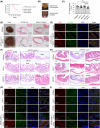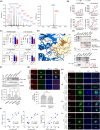PINK1 deficiency permits the development of Lewy body dementia with coexisting Aβ pathology
- PMID: 40990068
- PMCID: PMC12457948
- DOI: 10.1002/alz.70730
PINK1 deficiency permits the development of Lewy body dementia with coexisting Aβ pathology
Abstract
Introduction: Dementia with Lewy bodies (DLB), a prevalent neurodegenerative dementia, involves α-synuclein (α-syn) aggregates and frequent amyloid beta (Aβ) co-pathology, but mechanistic drivers remain unclear.
Methods: We crossed pink1 knockout with APP/PS1 mice, and assessed behavioral and pathological phenotypes of the resulting animals. We also performed biochemical and biophysical characterizations of PTEN-induced kinase 1 (PINK1) phosphorylation of α-syn.
Results: DLB brains show PINK1 deficiency alongside α-syn and Aβ co-pathology. Mirroring human DLB patients, APP/PS1::pink1-/- mice spontaneously develop Lewy pathology at endogenous α-syn levels, affecting both central and peripheral nervous systems with heterogeneous phenotypes. Mechanistically, PINK1 phosphorylates α-syn at Thr44, suppressing Aβ-induced α-syn aggregation. Moreover, pT44-α-syn levels are correlated with PINK1 expression and activity in human brains.
Discussion: PINK1 deficiency synergizes with Aβ to promote Lewy pathology via loss of protective α-syn phosphorylation. The APP/PS1::pink1-/- model recapitulates key DLB features without α-syn overexpression, offering a valuable tool for future mechanistic and therapeutic studies.
Highlights: PTEN-induced kinase 1 (PINK1) deficiency, either through reduced expression or impaired activity, is found in human dementia with Lewy bodies (DLB) patients with amyloid beta (Aβ) co-pathology. PINK1 specifically phosphorylates α-synuclein at Thr44, inhibiting Aβ-induced aggregation and preventing the development of Lewy pathology. The APP/PS1::pink1-/- mouse model recapitulates key features of human DLB, exhibiting widespread Lewy pathology and heterogeneous phenotypes. PINK1 alterations emerge as a novel genetic risk factor for DLB, opening new avenues for diagnosis and therapeutic intervention.
Keywords: APP/PS1 mouse; Alzheimer's disease; Lewy body; Lewy neurite; PTEN‐induced kinase 1; Parkinson's disease; amyloid beta; dementia with Lewy bodies; phosphorylation; α‐synuclein.
© 2025 The Author(s). Alzheimer's & Dementia published by Wiley Periodicals LLC on behalf of Alzheimer's Association.
Conflict of interest statement
The authors declare no conflicts of interest. Author disclosures are available in the supporting information.
Figures






References
-
- Hogan DB, Fiest KM, Roberts JI, et al. The prevalence and incidence of dementia with Lewy bodies: a systematic review. Can J Neurol Sci. 2016;43(1):S83‐S95. - PubMed
MeSH terms
Substances
Grants and funding
LinkOut - more resources
Full Text Sources
Medical
Research Materials
Miscellaneous

